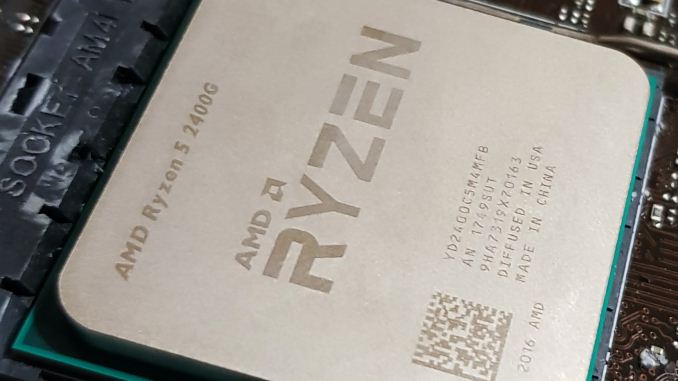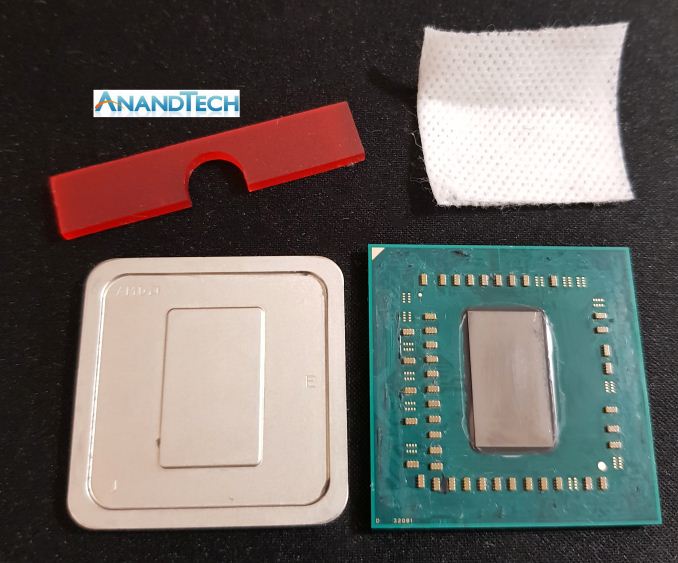AMD Ryzen 5 2400G and Ryzen 3 2200G Core Frequency Scaling: An Analysis
by Gavin Bonshor on June 20, 2018 10:05 AM EST- Posted in
- CPUs
- AMD
- Zen
- APU
- Vega
- Ryzen
- Ryzen 5
- Ryzen 3
- Scaling
- CPU Frequency
- Ryzen 3 2200G
- Ryzen 5 2400G

When AMD launched their first generation Ryzen-based APUs with a Zen cores and Vega graphics, both of the new parts entered the market at two very different budget-focused price points. The Ryzen 3 2200G, sitting at $99 for a quad-core CPU with Vega graphics was an amazing feat, and Ryzen 5 2400G coming in at $169 became the new integrated graphics champion. In our run of performance analysis articles, the question being asked today are relatively simple ones: 'how well do the new AMD Ryzen 2000 series APUs scale with core frequency'? We tested our APUs for standard benchmark performance, discrete gaming performance, and integrated graphics performance.
Core Frequency Scaling on The Ryzen 2000 Series
The perception when overclocking a CPU, or any other component for that matter, is that the increase in clock speed will directly correlate into better performance. The theory is pretty simple on paper, but the translation between the increase of clock rate and increase in performance can be a somewhat different story depending on the rest of the system or how the program is computed.
As a result, a 25% increase in clock speed only really correlates to a 25% jump in performance for the most simple programs, as there are many other limiting factors to consider such as bottlenecks on graphics, memory performance, or stalls in the compute pipeline.
In our testing for this article, we aim to go through and evaluate the differences and performance scaling at different frequencies on our APUs.
| AMD Ryzen 2000-Series APUs | ||
| Ryzen 5 2400G with Vega 11 |
Ryzen 3 2200G with Vega 8 |
|
| CPU Cores/Threads | 4 / 8 | 4 / 4 |
| Base CPU Frequency | 3.6 GHz | 3.5 GHz |
| Turbo CPU Frequency | 3.9 GHz | 3.7 GHz |
| TDP @ Base Frequency | 65 W | 65 W |
| Configurable TDP | 46-65 W | 46-65 W |
| L2 Cache | 512 KB/core | 512 KB/core |
| L3 Cache | 4 MB | 4 MB |
| Graphics | Vega 11 | Vega 8 |
| Compute Units | 11 CUs | 8 CUs |
| Streaming Processors | 704 SPs | 512 SPs |
| Base GPU Frequency | 1250 MHz | 1100 MHz |
| DRAM Support | DDR4-2933 Dual Channel |
DDR4-2933 Dual Channel |
| OPN PIB | YD2400C4FBBOX | YD2200C5FBBOX |
| OPN Tray | YD2400C5M4MFB | YD2200C4M4MFB |
| Price | $169 | $99 |
| Bundled Cooler | AMD Wraith Stealth | AMD Wraith Stealth |
Our previous articles covering the APU performance include a pure overclock analysis, as well as a detailed guide in delidding the processor for extra performance. We have a future article planned on memory performance.

After delidding the processor, for better thermal performance
For the testing, we took each of our APUs from 3.5 GHz to 4.0 GHz on the core frequency in 100 MHz jumps and performed our testing suite throughout. This correlates to a 14.3% performance jump overall, and matches the frequencies we saw in our overclocking articles. At each point we will compare to see if the performance uplift is even loosely correlated to CPU speed.
Test Bed Setup
As per our testing policy, we take a premium category motherboard suitable for the socket, and equip the system with a suitable amount of memory. With this test setup, we are using the BIOS to set the CPU core frequency using the provided straps on the MSI B350I Pro AC motherboard. The memory is set to the maximum supported frequency of DDR4-2933 with CAS latency timings of 18-18-18 within the BIOS to provide consistency throughout the different frequencies tested.
| Test Setup | |||
| Processors | AMD Ryzen 3 2200G | AMD Ryzen 5 2400G | |
| Motherboard | MSI B350I Pro AC | ||
| Cooling | Thermaltake Floe Riing RGB 360 | ||
| Power Supply | Thermaltake Toughpower Grand 1200 W Gold PSU | ||
| Memory | G.Skill Ripjaws V DDR4-3600 17-18-18 2x8 GB 1.35 V |
||
| Integrated GPU | Vega 8 1100 MHz |
Vega 11 1250 MHz |
|
| Discrete GPU | ASUS GTX 1060 Strix 1620 MHz Base, 1847 MHz Boost |
||
| Hard Drive | Crucial MX300 1 TB | ||
| Case | Open Test Bed | ||
| Operating System | Windows 10 Pro | ||
We must thank the following companies for kindly providing hardware for our multiple test beds.
Thank you to Crucial for providing us with MX300 SSDs. Crucial stepped up to the plate as our benchmark list grows larger with newer benchmarks and titles, and the 1TB MX300 units are strong performers. Based on Marvell's 88SS1074 controller and using Micron's 384Gbit 32-layer 3D TLC NAND, these are 7mm high, 2.5-inch drives rated for 92K random read IOPS and 530/510 MB/s sequential read and write speeds.
The 1TB models we are using here support TCG Opal 2.0 and IEEE-1667 (eDrive) encryption and have a 360TB rated endurance with a three-year warranty.
Further Reading: AnandTech's Crucial MX300 (750 GB) Review











29 Comments
View All Comments
eastcoast_pete - Thursday, June 21, 2018 - link
I hear your point. What worries me about buying second hand GPU especially nowadays is that there is no way to know whether it was used to mine crypto 24/7 for the last 2-3 years or not. Semiconductors can wear out if used for thousands of hours both overvolted and at above normal temps; both can really affect not just the GPU, but especially also the memory.The downside of a 980 or 970 (which wasn't as much at risk for cryptomining) is the now outdated HDMI standard. But yes, just for gaming, they can do.
Lolimaster - Friday, June 22, 2018 - link
A CM Hyper 212X is cheap and it's one the best bang for buck coolers. 16GB of ram is expensive if you want 2400 o 3000 CL15. 8GB is just too low, the igpu needs some of it and many games (2015+ already need 6GB+ of system memory)eastcoast_pete - Thursday, June 21, 2018 - link
Thanks for the link! Yes, those results are REALLY interesting. They used stock 2200G and 2400G, no delidding, no undervolting of the CPU, and on stock heatsinks, and got quite an increase, especially when they also used faster memory (to OC memory speed also) . Downside was notable increase in power draw and the stock cooler's fan running at full tilt.So, Gavin's delidded APUs with their better heatsinks should do even better. The most notable thing in that German article was that the way to the overclock mountain (stable at 1600 Mhz stock cooler etc.) led through a valley of tears, i.e. the APUs crashed reliably when the iGPU was mildly overclocked, but then became stable again at higher iGPU clock speeds and voltage. They actually got some statement from AMD that AMD knows about that strange behavior, but apparently has no explanation for it. But then - running more stable if I run it even faster - bring it!
808Hilo - Friday, June 22, 2018 - link
A R3 is not really an amazing feat. It's a defective R7 with core, lane, fabric, pinout defects. The rest of the chip is run at low speed because the integrity is affected. Not sure anyone is getting their money worth here.Lolimaster - Friday, June 22, 2018 - link
I don't get this nonsense articles on an APU were the MAIN STAR IS THE IGPU. On some builds there mixed results when the gpu frequency jumped around 200-1200Mhz (hence some funny low 0.1-1% lows in benchmarks).It's all about OC the igpu forgetting about the cpu part and addressing/fixing igpu clock rubber band effect, sometimes disabling boost for cpu, increase soc voltage, etc.
Galatian - Friday, June 22, 2018 - link
I'm going to question the results a little bit. For me it looks like that the only ”jump” in performance you get in games occurs whenever you hit an OC over the standard boost clock, e.g. 3700 MHz on the 2400G. I would suspect that you are simply preventing some core parking or some other aggressive power management feature while applying the OC. That would explain the odd numbers with when you increase the OC.That being said I would say a CPU OC doesn't really make sense. An undervolting test to see where the sweet spot lies would be nice though.
melgross - Monday, June 25, 2018 - link
Frankly, the result of all these tests seems to be that overclocking isn’t doing much of anything useful, at least, not the small amounts we see here with AMD.5% is never going to be noticed. Several studies done a number of years ago showed that you need at least an overall 10% improvement in speed for it to even be noticeable. 15% would be barely noticeable.
For heavy database workloads that take place over hours, or long rendering tasks, it will make a difference, but for gaming, which this article is overly interested in, nada!
Allan_Hundeboll - Monday, July 2, 2018 - link
Benchmarks @46W cTDP would be interestingV900 - Friday, September 28, 2018 - link
The 2200G makes sense for an absolute budget system.(Though if you're starting from rock bottom and also need to buy a cabinet, motherboard, RAM, etc. you'll probably be better off taking that money and buying a used computer. You can get some really good deals for less than 500$)
The 2400G however? Not so much. The price is too high and the performance too low to compete with an Intel Pentium/Nvidia 1030 solution.
Or if you want to spend a few dollars more and find a good deal: An Intel Pentium/Nvidia 1050.